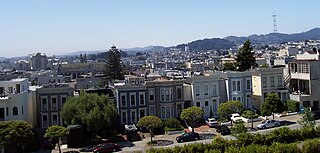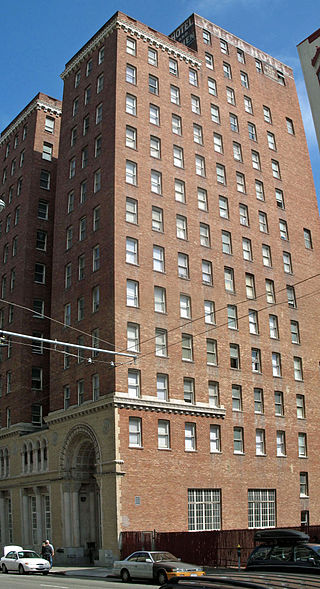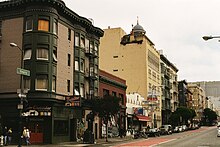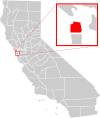
Japantown, also known historically as Japanese Town, is a neighborhood in the Western Addition district of San Francisco, California. Japantown comprises about six city blocks and is considered one of the largest and oldest ethnic enclaves in the United States.

Bernard Ralph Maybeck was an American architect in the Arts and Crafts Movement of the early 20th century. He worked primarily in the San Francisco Bay Area, designing public buildings, including the Palace of Fine Arts in San Francisco, and also private houses, especially in Berkeley, where he lived and taught at the University of California. A number of his works are listed on the National Register of Historic Places.

The Western Addition is a district in San Francisco, California, United States.

This is intended to be a complete list of the properties and districts on the National Register of Historic Places in San Francisco, California, United States. Latitude and longitude coordinates are provided for many National Register properties and districts; these locations may be seen together in an online map.

The Tenderloin is a neighborhood in downtown San Francisco, in the flatlands on the southern slope of Nob Hill, situated between the Union Square shopping district to the northeast and the Civic Center office district to the southwest. Encompassing about 50 square blocks, it is historically bounded on the north by Geary Street, on the east by Mason Street, on the south by Market Street and on the west by Van Ness Avenue. The northern boundary with Lower Nob Hill has historically been set at Geary Boulevard.
Cadillac Hotel may refer to:

The Ambassador Hotel is a six-story, 134-room single room occupancy hotel at 55 Mason Street in the Tenderloin district of San Francisco, California. The hotel was designed by Earl B. Scott & K. McDonald as the Ferris Harriman Hotel and Theater, and completed in 1911. It is a contributing property to the National Register of Historic Places's Uptown Tenderloin Historic District since 2009.

Albert Pissis (1852–1914) was a prolific Mexican-born American architect, of French and Mexican descent. He was active in San Francisco and had studied at the École des Beaux-Arts in Paris, France. He is credited with introducing the Beaux-Arts architectural style to San Francisco, California, designing a number of important buildings in the city in the years before and after the 1906 San Francisco earthquake.

McAllister Tower Apartments, also known as the William Taylor Hotel, is a 28-story, 94 m (308 ft) residential apartment skyscraper at 100 McAllister Street in San Francisco, California. The property is owned and operated by the University of California, Hastings College of the Law. The tower includes mixed-use offices on various floors, and the Art Deco-styled "Sky Room" with a panoramic view on the 24th floor.

Mid-Market is a neighborhood, historic district and development area in San Francisco, California. The neighborhood is bounded by Market Street to the north, 5th Street to the east, Mission Street to the south, and Van Ness Avenue to the west. There are many theaters in the district, most of which began as vaudeville theaters, include the Warfield and Golden Gate.
Oliver Marion Rousseau (1891–1977) was an American architect, home builder/contractor, and real estate developer. He worked in the San Francisco Bay Area, in particular the Sunset District of San Francisco, as well as Hayward, California. He came from a family of noted architects and co-founded the architecture firm Rousseau and Rousseau, and later the Marian Realty Co..

The Hotel Union, formerly the Rhodema Hotel and the San Carlos Hotel, at 811 Geary Street in the Tenderloin neighborhood of San Francisco, California.

The YMCA Hotel is a historic building in the Tenderloin District of San Francisco, California, United States. It is listed on the listed on the National Register of Historic Places in San Francisco, California since 1986; and it is a contributing property to the National Register of Historic Places's Uptown Tenderloin Historic District since 2009.
Sylvain Schnaittacher (1874–1926) was an American architect. He served as director and as president of the American Institute of Architects chapter in San Francisco, and then during 1918–1920 he served as the Western States regional director.

Alfred Henry Jacobs was an American architect. He designed theaters, hotels, residential, and religious buildings, primarily working in the San Francisco Bay Area. Three of the buildings he designed are listed on the National Register of Historic Places. He also worked as a watercolorist.

The Spero Hotel, originally the Hotel Californian and later the Serrano Hotel, is a historic hotel building at 403 Taylor Street in the Tenderloin neighborhood of San Francisco, California. It was designed by architect Edward E. Young and built in 1923. A four story addition designed by Alfred Henry Jacobs was completed in 1929. The 12-story hotel is at 405 Taylor Street. It underwent a $16 million renovation and became the Spero Hotel in 2018. It is listed on the listed on the National Register of Historic Places in San Francisco, California since 1998; and it is a contributing property to the National Register of Historic Places's Uptown Tenderloin Historic District since 2009.
Frederick Herman Meyer was an American architect. He was active in the San Francisco Bay Area, and is known for designing the YMCA Hotel in San Francisco. From c.1898 until 1901, Samuel Newsom worked with Meyer, to form the firm Newsom and Meyer in Oakland. Starting in 1902 and until 1908, Meyer entered into a partnership with architect Smith O'Brien to form the form Meyer and O'Brien.

The building at 1840–1842 Eddy Street, also known as the Martian O'Dea House, is a historic Stick/Eastlake house built in 1875 in the Western Addition neighborhood of San Francisco, California. It is notable for its architecture. It has been listed as a listed California Historical Landmark since 1973, and was listed on the National Register of Historic Places in 1973.

The Lower Nob Hill Apartment Hotel District is a historic district located in downtown San Francisco, California, in an area that sits between the Nob Hill and Tenderloin neighborhoods. It covers roughly a five-block stretch on the southern slope of Nob Hill, but due to its location between California Street and Geary Street, the district is often considered part of downtown San Francisco. The area is sometimes referred to as 'Tendernob,' a colloquial term that reflects the blending of the two neighborhoods, and is also commonly called 'Lower Nob Hill' by real estate agents and developers to market properties in this transitional zone.

The Cadillac Hotel is a historic building from c. 1907 – c. 1908 in the Tenderloin neighborhood of San Francisco, California, U.S.. It was the first non-profit single-residence occupancy (SRO) hotel in the Western United States. Since 2015, the first two floors of the building is the home to the Tenderloin Museum, a cultural history museum dedicated to the neighborhood. It was called the A.A. Louderback Building, and nicknamed "The House of Welcome" during the early 20th-century.





















